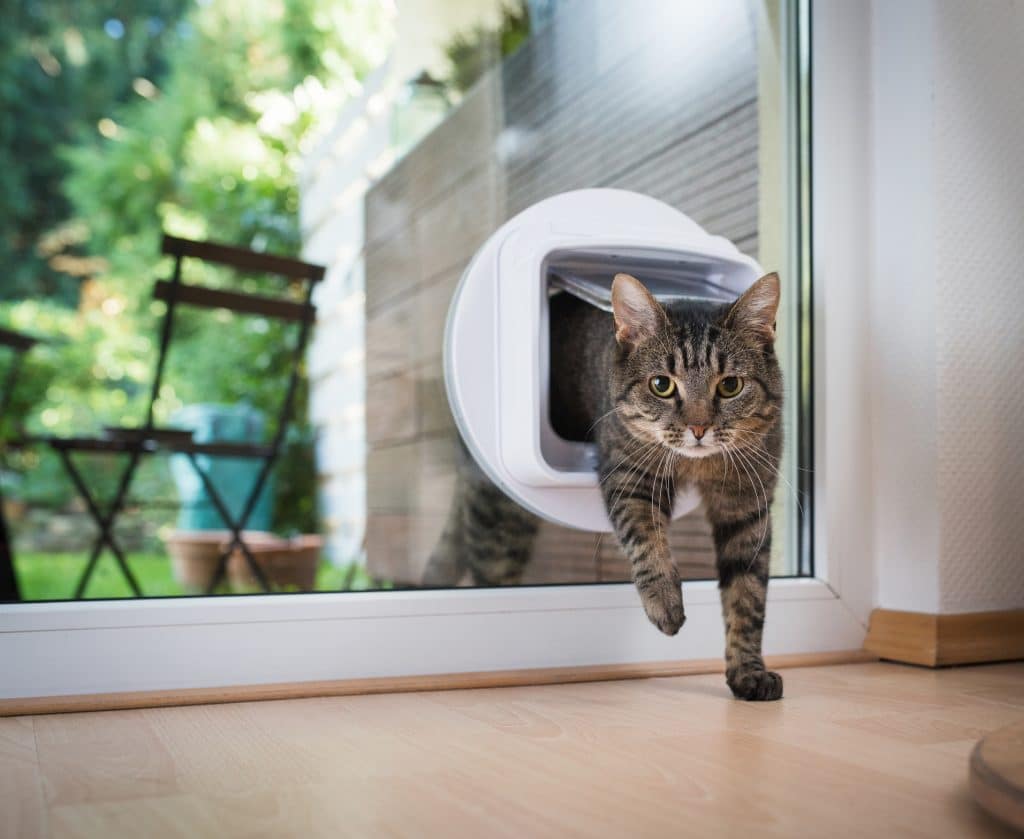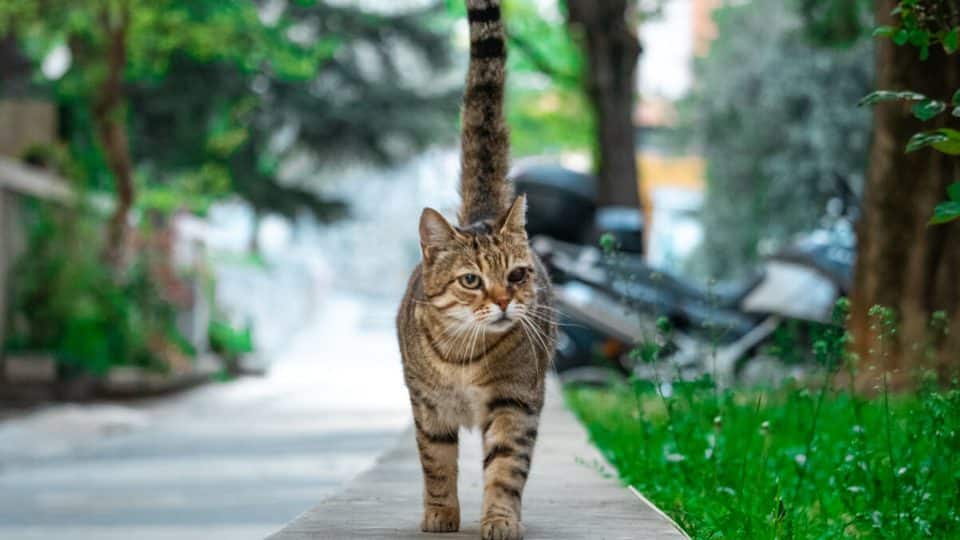Most cats in the UK enjoy outdoor life. But what can you do to ensure safety when and if you let your cat outside for the first time? While allowing cats to roam may satisfy an instinct for exploration, it also poses various risks—especially when done incorrectly.
Here we explore the pros and cons of allowing your cat outside, whether to let them roam beyond your garden, the different approaches to letting kittens and older adopted cats outside for the first time, and top tips for ensuring safety.
Letting Cats Outside: The Benefits
According to Cats Protection, there are more than 10.8 million cats in the UK and the vast majority have access to the outdoors. Most cats live a full and happy life exploring their garden—and often beyond—while returning home for meals, warmth and rest.
As domestic cats descend from the African wildcat, allowing them outside channels natural behaviours “deeply ingrained” in their genetics, explains Oliver Liebster, veterinary surgeon at Village Vet Hampstead in London.
“Outdoor environments provide natural stimuli, exercise, and opportunities to hunt or explore, which can satisfy their instinctual needs,” he says.
While this enrichment can be provided indoors, Dr Liebster warns that keeping cats inside without meeting these instinctive needs leads to “boredom and frustration”. This can cause behaviour such as excessive grooming or pacing.
Outdoor exercise can also keep a cat’s weight in check, which can help prevent many health conditions including arthritis and urinary tract problems, as Katie Fulcher, registered veterinary nurse at Village Vet Milton, Cambridge, points out.
She adds: “Many cats also prefer to toilet outside, and toileting frequently and comfortably is ideal to reduce their risk of contracting FLUTD (feline lower urinary tract disease), which can lead to severe complications.”
But both Fulcher and Sally Chamberlain, a clinical animal behaviourist specialising in cats, agree that felines with outdoor access still need human interaction and plenty of opportunities to play when indoors.
“Being outside is not a requirement for cats, nor is it an excuse for a lack of socialisation or interaction from their owners,” Fulcher adds.

Image credit: Tatiana Stepanishcheva | iStock
Letting Cats Outside: The Downsides
Allowing your cat outside doesn’t come without risk. It exposes them to dangers such as road traffic collisions, scrapes with other cats or dogs and other injuries.
“It can also have a significant impact on local wildlife such as birds, mammals, and reptiles,” says Dr Liebster.
“Owners of outdoor cats should consider measures such as limiting outdoor access with timed cat flaps or confining cats to secure garden spaces with high overarching fences, to help reduce hunting opportunities and protect wildlife,” he explains.
Cats who roam are also susceptible to getting lost, especially if allowed outside too soon or without the correct training. In addition, unvaccinated and unneutered cats run the risk of illness and breeding, adding to already high stray cat numbers.
Those with illnesses such as FIV (feline immunodeficiency virus) and FeLV (feline leukaemia virus) should be kept inside for their own safety and that of other pets. Injury, and sight and hearing impairments are also good reasons to prevent cats from going outside.
Meanwhile, certain breeds, like Persians, can be less inclined to explore or equipped to handle the hazards it brings. Proximity to busy roads is also a factor to consider.
Unless a cat is used to roaming and would be stressed without the opportunity, they “don’t necessarily have an instinct to roam unless they are unneutered,” says Chamberlain.
“It depends on where you live and how street-wise your cat is but there are always risks to letting your cat have free rein outdoors, such as being hit by a car or injured in other ways,” she adds.
Due to this, Chamberlain recommends preventing cats from roaming. Instead, she advises confining them to secured gardens, catios (enclosed cat-friendly patios) or walking them on a lead and harness outside where appropriate and possible.
Enrichment For Indoor Cats
All cats, whether they go outside or not, need some level of enrichment indoors.
But in scenarios that mean your cat cannot have outdoor access, whether due to injury, illness or environment, they will need extra play and attention to keep them happy and healthy.
In the absence of a catio or enclosed garden, Chamberlain says bringing outdoor enrichment inside and creating an “indoor garden” with cat-safe plants such as cat grass and catnip is a good idea.
When it comes to play, she emphasises that wand toys mimicking the movement of natural prey are an “essential part” of a cat’s daily routine.
Training sessions keep feline minds busy and engaged while increasing their bond with their human. Puzzle toys or simply hiding kibble around the home are other ways to improve mental stimulation.
Dr Liebster adds that tall cat trees for climbing and toy mice to chase are other enrichment tools “key to a cat’s physical and mental wellbeing” when staying indoors.
Many cats lead happy lives as indoor pets, and Chamberlain and Fulcher agree that outdoor access is not always necessary.
Veterinary Considerations For Outdoor Cats
All cats, regardless of outdoor access, should be up-to-date with core vaccinations and flea, tick and worming treatments. Outdoor cats need to be immunised against FeLV, feline panleukopenia and cat flu. Infected cats or carriers of any of these conditions should be kept inside. Thankfully, rabies is not a risk for UK cats as it is in other countries.
Neutering your cat before letting them outside is crucial. Kittens as young as four months reach sexual maturity and are therefore able to breed. Letting an unneutered cat outside will inevitably add to the stray cat population—estimated to be at nearly 250,000 in the UK—and put additional pressure on pet rescue organisations.
And Dr Liebster points out that fighting is more prevalent among unneutered cats. “Unneutered male cats, driven by high testosterone levels, are prone to fighting over territory and mates, which can lead to injuries such as scratches and bites.”
By law, every cat in the UK has to be microchipped from 20 weeks old. Not doing so leaves you liable for a fine of up to £500. A microchipped cat can be reunited with you if lost and handed in to a vet or a rescue centre.
“This [microchipping] is vital as young cats, or adult cats new to an area, can easily wander too far or find themselves lost,” adds Fulcher.

iStock/Ivan-balvan
How Long Should I Wait Before Letting My Cat Outside?
Opening the door to allow your cat to explore the great outdoors for the first time can be a daunting and unnerving experience. However, adopting the right timescales, preparation and training can make this a rewarding experience for both pet and owner.
When To Let Your Kitten Outside For The First Time
Among the risks for small kittens venturing outside are illness and predators. Dr Liebster and Chamberlain recommend that new cat parents wait at least six months before allowing kittens access to the outdoors.
“Kittens should not be allowed to roam outdoors until they reach full maturity, are at least six months of age and weigh at least two kilograms,” Dr Liebster says.
In the meantime, there’s plenty of preparation needed to ready your cat for the great outdoors—more on that later!
But Chamberlain adds: “If a kitten is happy enough living indoors, they may be better off as an indoors-only cat. They would be very vulnerable outside at such a young age if they were allowed to roam freely outdoors.”
When To Let An Adopted Cat Outside For The First Time
Allow adult cats time to settle into their new home as well as bond with you before letting them outside. This will vary between individual cats but, as a general rule of thumb, Chamberlain recommends waiting at least three weeks.
“It depends on the cat and how safely they can be let outdoors without any chance of them leaving their own garden,” adds Chamberlain.
Letting a newly adopted cat outside too soon leaves them very vulnerable to getting lost. For rescue pets not used to outdoor access, Chamberlain suggests considering keeping them as an indoor cat.
When To Let Out A Cat After Moving Home
Again, this will depend on how quickly your cat adapts to their new home. But about three weeks is the recommended timescale for allowing your cat outside after moving home, says Chamberlain.
Positively building up time in new outdoor spaces helps reduce the risk of cats returning to their old home.
Find out more about moving homes with your cat.

bombermoon via iStock
How To Prepare Your Cat For Going Outside
Aside from the considerations above, you’ll need to prepare your cat for outdoor life and teach them to return home.
Recall training started inside, particularly for kittens, is essential before letting your cat outside for the first time. Instilling a solid recall, alongside gradually building up supervised time outside in the garden—ideally before mealtimes served indoors—helps establish a routine for your cat and ensures that they associate returning home with tasty food and fuss.
Start with short, 30-minute supervised sessions outside built up over a few weeks. Restrict this to daylight hours, advises Fulcher, as darkness brings additional risks like getting lost or accidents.
“Always start outside training first thing in the morning before feeding your cat,” says Fulcher. “Allow your cat access to the garden for a few minutes, then encourage them back inside using treats and the allure of breakfast.”
Slowly increase the time your cat spends outside while using a consistent recall cue to lure them back inside.
Before letting your cat outside for the first time you should also:
- Rub their scent on garden objects so they feel more familiar
- Sprinkle some soiled litter around the garden perimeter to help establish their territory
- Cover any ponds in your garden
- Remove any toxic plants or any other harmful items
- Close the windows and doors to any sheds or garages containing hazards
Never carry cats into the garden, warns Fulcher. “Cats secrete a scent from their paws when they walk, which they can follow like a trail back to their home,” she explains.
Chamberlain, meanwhile, recommends keeping cats on a lead and harness in the garden initially. This will fulfil some cats’ needs, she says.
Extra Safety Measures For Outdoor Cats
As well as microchipping and health factors, extra safety measures for outdoor cats include a collar and ID tag. This makes you contactable by anyone concerned about your pet, whether they’re lost or injured.
However, not all cats will be used to or happy to wear a collar. If they are, always make sure you buy a quick-release collar. This means that if it gets caught on anything it does not risk injuring or strangling your cat. Reflective collars also provide extra safety at night.
GPS cat trackers offer additional peace of mind to concerned cat parents. These use powerful technology to follow your cat with satellite or cellular coverage, linked to your mobile phone. This can be a significant investment, though, as most trackers require a subscription to keep your kitty’s live location up-to-date. And the trackers may be too heavy for cats, especially those not used to wearing collars, emphasises Chamberlain.
For the safety of wildlife, Fulcher recommends putting a bell on the collar of cats with a high hunting drive to give wildlife a chance to escape. She adds: “Avoid giving your cat access to the outside during dawn and dusk when native species such as hedgehogs, birds and bats are at their most active.”

Nils Jacobi / iStock
Cat Flap Benefits and How To Train Your Cat To Use One
Once you’re confident in letting your cat outside, a cat flap ensures they can come and go as they please. This is great for pet parents who are out during the day and can’t maintain their cat’s outdoor routine.
Chamberlain says: “Training a cat to get used to a cat flap can be done in small stages starting with the cat flap being open and gradually closing it little by little until the cat gets used to pushing it.”
Worried about other neighbourhood kitties coming into your home? Individual microchips activate many modern cat flaps, allowing pets free access but stopping friends or rivals from following.
What Do I Do If My Cat Doesn’t Return Home
Cats are naturally curious but cautious creatures, so try not to panic when they venture out of sight. They will often return within a few minutes when they initially start going outside.
If they don’t, check places they may visit. Use your recall cue and shake a bag of treats to lure them home. If they are missing for an unusual amount of time, ask neighbours to check inside garages and sheds. Put up posters and notify local vets and rescue organisations so that they can keep an eye out.
Fulcher also recommends calling them home at various times of the day in addition to encouraging them back using scent.
“If your cat has wandered too far, place a pile of your dirty laundry outside the door and at the end of the garden to provide a strong scent for them to follow,” she says. “This also works for their dirty litter tray.”



